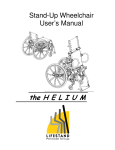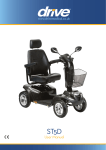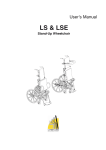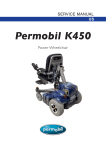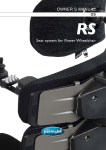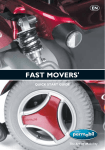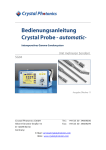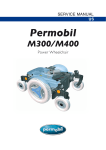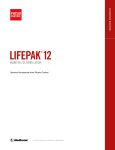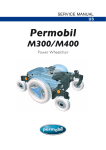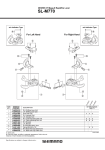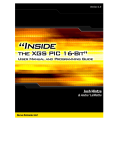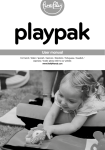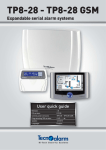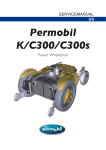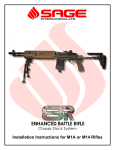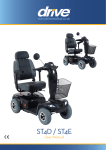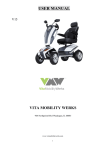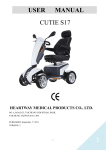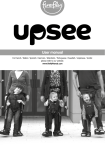Download LSR Kid - Algol Trehab
Transcript
USER MANUAL EN User manual LSR Kid Wheelchair with stand-up function User Manual LSR Kid Where to find LifeStand Contact us if you have any questions regarding servicing or sales in the area where you live. For the United Kingdom Permobil UK Oceanic Ground Floor Navigation Business Park Waters Meeting Road Bolton BL1 8SW Tel. (+44) (0)1484 722 888 Fax (+44) (0)1484 723 013 E-mail:[email protected] For all other countries: LifeStand France SAS 5 Rue Clément Ader 69740 Genas France Tel. : (+33) (0)4 37 26 27 28 Fax : (+33) (0)4 37 26 27 29 Email : [email protected] 3 LSR Kid Wheelchair with stand-up function Produced and published by Permobil AB, Sweden Version: 2, 2014-02 Order no.: 205276-UK-0 User Manual LSR Kid Contents Indications and Contraindications for the Use of Stand-up Wheelchairs ..................................... 6 Important information....................................................................................................................... 8 General information.......................................................................................................................... 9 Technical support..................................................................................................................... 9 Spare parts & accessories........................................................................................................ 9 Scrapping.................................................................................................................................. 9 Warranty................................................................................................................................... 9 Incident reporting..................................................................................................................... 9 Product approval....................................................................................................................... 9 Safety rules and regulations.................................................................................................. 10-19 Design & function........................................................................................................................... 20 General - overview................................................................................................................. 20 Raising function...................................................................................................................... 21 Control panel for raising function........................................................................................... 22 Operation........................................................................................................................................ 23 General .................................................................................................................................. 23 Armrests................................................................................................................................. 23 Raising function...................................................................................................................... 24 Driving Rules ......................................................................................................................... 28 Adjustment..................................................................................................................................... 32 Legrest and footplate . ........................................................................................................... 32 Knee supports ...................................................................................................................... 34 Seat depth ............................................................................................................................ 36 Center of gravity ................................................................................................................... 37 Seat width . .......................................................................................................................... 37 The height of the armrest ..................................................................................................... 38 The length of the armrest ..................................................................................................... 40 Back rest angle . ................................................................................................................... 41 Height of the Push handles/Back rest frame . ...................................................................... 42 Height of the Back rest ......................................................................................................... 44 Replacing/Reconfiguration of the backrest straps . .............................................................. 45 Equalization system . ............................................................................................................ 46 Anti-tip protection . ................................................................................................................ 48 Brakes .................................................................................................................................. 49 Transport........................................................................................................................................ 50 Wheels.................................................................................................................................... 51 Back rest................................................................................................................................. 52 Lifting points .......................................................................................................................... 53 Maintenance and repairs................................................................................................................ 54 General................................................................................................................................... 54 Batteries, storage.................................................................................................................... 55 Charging batteries.................................................................................................................. 56 Cleaning.................................................................................................................................. 57 Wheels.................................................................................................................................... 58 Serial number label ...................................................................................................................... 59 Power Module .............................................................................................................................. 60 The emergency standing-sitting function . ............................................................................ 60 Recommended Seat Cushions .................................................................................................... 61 Technical specifications................................................................................................................. 63 5 User Manual LSR Kid Indications and Contraindications for the Use of Stand-up Wheelchairs Indications and Contraindications for the Use of Stand-up Wheelchairs Advice: These indications and contraindications are based on general observations. The conditions for regular standing training varies from person to person and should be individually agreed with a doctor or therapist. Only a doctor or therapist can decide which method and safe standing training can be achieved with the Lifestand wheelchair. Indications Lifestand wheelchairs were specifically developed for people who have lost their ability to stand (e.g. paraplegia, multiple sclerosis, cerebral palsy etc.). Standing is used for therapy and prophylaxis of: - Osteoporosis Without regular standing / vertical stress of the bones, bone density can steadily decrease. This leads to the risk of bone fractures and other complications. - Decubitus prophylaxis Whilst standing the pressure on the ischial tuberosity is reduced to a minimum. - Skeletal misalignments / back pain Whilst seated the spinal column is naturally elongated (kyphosis/hunchback). Standing facilitates a natural spinal position and therefore better upper body stability. This prevents the risk of a scoliosis. - Muscular atrophy Without regular leg movement, the risk of muscle shortening increases (muscular atrophy) and consequently contractures may develop. Regular, self-standing training help as movement therapy, thereby avoiding contractures and preventing possible associated pains and expensive operations. - Tonus regulation of spasticity Frequent standing helps to reduce spasticity and facilitates seat movement and positioning in the wheelchair or bed. This supports a peaceful sleep. 6 User Manual LSR Kid Indications and Contraindications for the Use of Stand-up Wheelchairs - Deeper respiration Straightening the upper body through standing decreases the pressure of the abdominal cavity on the lungs. This improves and deepens respiration, facilitates breathing and can also help reduce the risk of pneumonia. - Gastrointestinal complications As with breathing, standing also reduces the pressure on the digestive system. This facilitates digestion (intestinal peristalsis) and helps with the improvement of bowl and bladder functions. Contraindications Warning: A Lifestand wheelchair can only be used upon prescription by a doctor. Here are the most common contraindications for the use of a Lifestand wheelchair. - Reduced bone density Should the bones already be very weak it is not recommended to stand. This could lead to fractures. In this case consult your doctor for a bone density measurement. - Poor circulation For heart or circulatory diseases standing should only occur under medical supervision (cardio training). Please consult a doctor in this case. - Severe mobility limitations or severe contractures 7 User Manual LSR Kid Important information Important information about the user manual Congratulations on choosing a LifeStand stand-up wheelchair. Our aim is your continued satisfaction with your choice of supplier and wheelchair. Before you start using your wheelchair, it is important to read and understand this user manual and in particular the section on Safety. The user manual is primarily intended to inform you about the functions and capabilities of your wheelchair and to advise you on the best way of using it. It also contains important safety and maintenance information and describes some of the problems which might arise when you drive the wheelchair. Always keep the user manual on or near your wheelchair, as you may need to consult it for essential information on use, safety and maintenance. You can also find information on our products on our website. You will find us at www.permobil.com. All information and all photographs, illustrations and specifications are based on the product information that was available at the time this user manual was printed. Fig.s and illustrations that appear in the user manual are typical examples and are not intended to be exact depictions of different parts of the wheelchair. We reserve the right to make changes to the product without prior notification. If you are visually impaired, this document can be viewed in PDF format at www.permobil.com or alternatively ordered in large text. Benefits of a Daily Standing Regimen The use of any stand-up device should be done only under the prescription and supervision of a medical professional. At the outset, it is recommended that your introduction to regular standing be closely monitored by your Physical or Occupational Therapist. It has been documented that the regular and cyclical activity of going from the seated to the standing position may offer many benefits to those that are no longer able to stand on their own. The benefits are two fold: 1) there is the ability to once again function in daily activities that necessitate standing (reaching file cabinets and equipment in the workplace, accessing cupboards/stoves/shelving at home, as well as the ability to interact eye to eye); and, 2) the potential of physical benefits that result from repeated standing (these benefits may include improved; range of motion, bone density, circulation, bowel and bladder function, etc.). 8 User Manual LSR Kid Technical support, warranty, etc. Technical support In the event of technical problems, you should contact your dealer or Permobil Life Stand Service Center at + 31 (0)45 564 54 90. Always state the wheelchairs serial number when contacting Permobil to ensure that the correct information is provided. Spare part & accessories Spare parts and accessories must be ordered through your dealer. The expected service life of this product is 5 years. Scrapping Contact Permobil BV or your dealer for information about scrapping agreements in force. Warranty All wheelchairs are supplied with a two-year product guarantee. Batteries and charger are supplied with one year warranty. Incident reporting If an incident occurs please contact your nearest Permobil representative. Normally the same person you contacted at purchase day. To prepare this contact there is a link on our homepage, on the internet, at www.permobil.com. Open up your country page and the contact page. Here is the needed contact information and a guidance document in what information we need to investigate the incident. Complete the information as much as possible. This is of great help for us. To increase the product quality and to ensure that our product is safe through the whole life cycle we need you to send in Incident Reports. It is also stated in MEDDEV 2.12-1 and Annex 9 that the manufacturer shall “Encourage users or those given specific responsibility for reporting incidents that have occurred with medical devices and that meet the criteria within these guidelines to report the incidents to the Manufacturer and or to the Competent Authority in accordance with national guidance”. To meet the requirements and to ensure that our products shall remain safe in your hands we need your assistance. We hope you never need to use the information on this page but if there is an incident please contact us. Product approval This product fulfill the requirements according to EN 12183, ISO 7176-16:1997, ISO 7176-8 and ISO 7176-14:2008. 9 User Manual LSR Kid Safety rules and regulations Safety rules and regulations A stand-up wheelchair is a complicated product. Therefore, you need to be very careful when you use and handle it. It is important to read and follow the instructions and safety rules given in this user manual before starting to use your wheelchair, as incorrect use could lead to injury to the user or damage to the wheelchair. Warning labels The user manual contains the following "warning labels" which are intended to draw attention to situations which could lead to problems, near-accidents, personal injury or damage to the wheelchair, etc. m CAUTION! Take care here. m WARNING! Take extra care here. Risk of personal injury or damage to the wheelchair and its surroundings. Permobil accepts no liability for personal injury or damage to property which may arise from the failure of the user or other persons to follow the recommendations, warnings and instructions given in this user manual. 10 User Manual LSR Kid Safety rules and regulations Safety rules and regulations Your wheelchair may have been adjusted precisely to your needs on delivery, so you should always ask the advice of the person who provided the seat for you before making changes or adjustments to the wheelchair. Certain adjustments may impair the wheelchair's safety/functions or its suitability for your needs. It is also extremely important to take the necessary time to familiarize yourself with the raising function of the wheelchair before you start using it. Do not make your first attempt to stand up on your own. Make sure you have assistance close by if you should need help. To ensure that the seat has not been damaged during transport to you, please check the following before initial use: • Check that all products ordered are included in the delivery. If you suspect that something is missing, contact your mobility aids center or Permobil as soon as possible for further information. • Check that no transport damage or other damage has occurred to the seat or its accessories. If you discover any damage or notice any other problem, contact your mobility aids center or Permobil as soon as possible for further information before continuing your inspection. Also check that the air pressure in the wheelchair tires is correct before you start using the wheelchair. If, in any situation, you find that the wheelchair does not behave as expected or you suspect that something is wrong, contact your service contact or Permobil for information. 11 User Manual LSR Kid Safety rules and regulations Safety rules and regulations m CAUTION! Operation Do not allow children to drive the wheelchair unsupervised. Do not use the wheelchair on public streets and roads. Follow local regulations for pedestrians and remember that vehicle drivers may find it difficult to see you. Do not drive the wheelchair if you are under the influence of alcohol. Alcohol may affect your ability to use the wheelchair safely. Some physical limitations or the ingestion of medicines, either prescription or over the counter medicines, may limit your ability to use the wheelchair safely. Always consult your physician about your limitations and medicines. m WARNING! Maintenance and service Carry out only the servicing and maintenance activities indicated in this user manual. All other servicing, changes and interventions in the wheelchair should be carried out by a qualified service engineer or a person with adequate knowledge to undertake this in an expert manner. In case of doubt, always contact a qualified service engineer or Permobil. Weight limits The maximum user weight for your wheelchair is specified in the specifications section of this user manual. If the wheelchair is used by anyone who weighs more than the maximum permitted user weight, the result may be personal injury or damage to property, including damage to the wheelchair. This may also invalidate the wheelchair's warranty. Do not carry passengers on the wheelchair. This can lead to personal injury and damage to the wheelchair. 12 User Manual LSR Kid Safety rules and regulations Safety rules and regulations m WARNING! Driving on sloping surfaces When you drive up a slope, ensure that you drive the wheelchair straight up the slope (vertically). If you drive at an angle, there is an increased risk of tipping over or falling. Be extremely careful when you drive up a slope. Always avoid driving on slopes covered with snow, ice, gravel, clay, sand, wet leaves or similar, or where the surface is uneven. m WARNING! Operation - turning/cornering The risk of the wheelchair tipping over increases at high turning speed, in tight curves, on uneven surfaces, with fast changes of direction and if you drive from a place with low friction (for example a lawn) to a place with high friction (for example a gravel road). To avoid tipping over, with the risk of personal injury or damage to property that entails, you should always drive slowly when turning/cornering and changing direction. Driving on steps and stairs Wherever you come across obstacles, you should always approach them slowly, preferably in the company of another person watching or helping you. The front wheels can be raised from the ground by your carer by treading on the anti-tip protection on the rear of the chair and pulling back and down on the carer handle at the same time. Although it is not recommended for the chair to be tipped back any further (the anti-tip protection will touch the floor), it is possible. This is done by turning the anti-tip protection to the upper position (see page 48). Make sure to put the anti-tip protection into operational mode again once the procedure is complete. Driving on inclines When moving uphill, always lean forwards and avoid changing direction suddenly. When moving downhill, always lean backwards. It is also important to keep speed and direction under control. Make sure that the wheelchair is facing up or down the hill. Never try to drive diagonally or swing down a slope. 13 User Manual LSR Kid Safety rules and regulations Safety rules and regulations m WARNING! Passengers The wheelchair is not designed to transport passengers, whatever their age. Nor is it designed for taking heavy items other than the user's personal belongings. The maximum user weight specified in the user manual for the seat in question must not be exceeded. Ignoring this could impair the wheelchair's maneuverability and stability. Operation in different climates Avoid exposing the wheelchair to very low temperatures, prolonged moisture, heavy rain/snowfall and similar situations. Do not use the wheelchair when it is icy or slippery outdoors. These conditions may impair the performance and safety of the wheelchair, which could result in accident, personal injury and damage to property, including damage to the wheelchair. Keep in mind that certain areas of the wheelchair, when exposed to external sources of heat (e.g. sunlight), can increase in temperature. 14 User Manual LSR Kid Safety rules and regulations Safety rules and regulations m WARNING! Seat belt (Optional) The seat belt is only designed to hold the user in place and not as protection in the case of collision/accident. Check the condition of the belts regularly in case any damage or worn places have developed. If damage has occured, contact your equipment provider for replacement. Getting in and out of the chair Make sure the wheelchair brakes are activated before getting into or out of the wheelchair. When getting into or out of the wheelchair, you should take all precautions to reduce the distance between the wheelchair and the point to which the user is moving. If this distance is increased, it could result in the user losing balance or falling over. We recommend that users get in and out with another person present to keep an eye on the operation or to help. Be careful when bending down or reaching out to get something. Do not use the foot plates or armrests as supports when getting into or out of the wheelchair. The foot plates and armrests are not intended to support heavy loads. Unnecessarily high load could cause them to give way, which could result in personal injury or damage to property, including damage to the wheelchair. 15 User Manual LSR Kid Safety rules and regulations Safety rules and regulations m WARNING! Transport The wheelchair must only be transported in vehicles approved for this purpose. Carefully check that the wheelchair is properly secured. An inadequately secured wheelchair could cause major damage and injury if it broke loose, both to persons in the transport vehicle and to the vehicle and the wheelchair itself. Use in motor vehicles forbidden We recommend that users are NOT transported in any vehicle while seated in the wheelchair. The only safe option is for the user to move to a seat in the vehicle and to use the vehicle's seat belt system. Do not sit in the wheelchair in a moving vehicle. In the event of an accident or a sudden stop, the user could be thrown from the chair, resulting in serious injuries. The optional seat belt is solely designed to hold the user in place and offers no protection in the event of an accident. The sticker indicates that the wheelchair is not approved to use as a seat in motor vehicles. 16 User Manual LSR Kid Safety rules and regulations Safety rules and regulations m CAUTION! EMC Requirements The electronics of an power wheelchair can be affected by external electromagnetic fields (for example from mobile telephones). Similarly, the electronics of the wheelchair itself can also emit electromagnetic fields that can affect the immediate surroundings (for example certain alarm systems in businesses). The limit values for Electromagnetic Compatibility (EMC) with respect to power wheelchairs is set in the harmonized standards for the EU in the Medical Devices Directive, No. 93/42/EEC. Permobil LifeStand’s electronic wheelchair’s comply with these limit values. m WARNING! Flame resistance The material components have been tested against flammability. Seat cushion and back cushion have been tested according to European flammability testing. (EN1021-1:2006 and EN1021-2:2006). The control box has been tested according to UL 94-VO. Maintenance and service Carry out only the servicing and maintenance activities indicated in this user manual. All other service, alterations and changes to the wheelchair and the vital systems of its accessories must be carried out by a competent service engineer or a person suitably qualified to do so in an expert manner. In case of doubt, always contact a qualified service engineer or Permobil. Use only spare parts or accessories approved or recommended by Permobil. All other use could lead to changes which might impair the functions and safety of the wheelchair. It could also lead to the warranty for your wheelchair becoming invalid. 17 Safety rules and regulations User Manual LSR Kid m WARNING! Damage to/breakdowns in the wheelchair and its accessories If at any point you notice that the wheelchair and its various functions are not behaving as expected or if you suspect something is wrong, stop using your wheelchair as soon as possible, turn off the wheelchair and contact your mobility aids center or Permobil for information. It is extremely important that Permobil is informed if the wheelchair or its accessories have been damaged during transport, during driving or for any other reason as soon as possible after the damage has occurred. There could be a risk that the wheelchair and its accessories can no longer be operated safely and without danger. Disposal Used wheelchairs and batteries, or defect batteries must be disposed of according to applicable local waste disposal regulations and in an environmentally friendly manner. 18 Safety rules and regulations User Manual LSR Kid WARNING! Clamping points In the following positions of the wheelchair there is an increased risk of entrapment. Please exercise particular caution here. Pay attention to the marked areas on the gap between moving and stationary parts. Danger that lose items of clothing or hands could become clamped. 19 User Manual LSR Kid Design and function Design & function General LSR Kid is a manual wheelchair for outdoor and indoor use. It is intended for kids with physical disabilities. Its raising function allows the user greater freedom of movement. We recommend gradual training in standing up under the guidance of a physiotherapist before you use "LSR Kid" every day. You will gain the greatest benefit in standing up if you regularly switch between a sitting and a standing position. This alternation is simple with the LSR Kid wheelchair. The wheelchair is equipped with armrests, footplates, anti-tip protection and battery charger. Overview 5 1 2 6 3 4 7 1. 2. 3. 4. 5. Back rest 6. Rear wheels 7. Front wheels Armrest Knee supports Leg rest Foot plate 20 User Manual LSR Kid Design and function Raising function The electric raising function makes it possible for the user to stand up in their wheelchair. This function is accessed from a control panel located on one armrest. Stand-up function 21 User Manual LSR Kid Design and function Control panel for raising function The control panel has two buttons to control the seat's raising function. The control panel can be fitted to either armrest in the position that best suits the user. There is a socket at the front of the control panel for connecting the accompanying battery charger. Function keys 22 User Manual LSR Kid Operation Operation General LSR Kid is designed for use both indoors and outdoors. For use indoors, attention must be paid when driving in narrow corridors, when passing through doors and entrances and when traveling on elevators and ramps, etc. Remember that there is a risk of crushing when using the electrical raising function. Outdoors you must remember to travel very slowly on steep downhill slopes and take great care on uneven surfaces, uphill slopes and sideways gradients. Always observe a good safe distance when driving near edges and precipices. We recommend that you practice in an environment in which you feel safe so that you are very familiar with how the wheelchair and its accessories behave in different situations before you start to use the wheelchair in public locations. Armrests The armrests can be folded backwards to facilitate when getting in and out of the chair. See fig. below. 23 User Manual LSR Kid Operation Raising function General The wheelchair seat is operated via its control panel. The control panel has two buttons. Before using the raising function, it is extremely important that all the seat's settings are adapted to the current user. More detailed information on adjustments can be found on pages 32-49. Left button (Arrow forward) This button is used to operate the raising function from sitting to standing position, or to move from reclined to sitting position. Right button (Arrow backward) This button is used to move from standing to sitting position, or to move from sitting to a reclined position. NOTE! The raising function will only work when the knee support is correctly mounted and the armrests are in raising position. See page 26-27. Control panel m WARNING! Use the raising function with great care and be aware of the danger of crushing. Using the control panel, the position of the seat can be changed between reclined, normal sitting and standing position. 24 User Manual LSR Kid Operation Raising function m WARNING! Make sure that the wheelchair is on a flat, horizontal surface, free of obstacles or ground depressions. Make sure the brakes are activated! If this is not the case, the wheelchair may roll away, with the risk of personal injury. Make sure that the knee supports are correctly secured. See page 26. Make sure that the armrest is correctly secured in the raising position. See page 27. During the activation of the electric function to reach the standing- or the relax position, make sure to keep your arms on the armrests. You might trap your fingers into the moving parts, especially around the armrest. During the activation of the electric function to reach the standing- or the relax position, make sure to keep your arms on the armrests. Raising Press the right or left button, depending on whether the seat is to be raised to the standing position or lowered to the normal or reclined position. To stop the system, release the button. You can stop at any intermediate position. Once the system has reached its end point, it will stop automatically. m CAUTION! Stress on the muscles may be relieved by taking regular rest periods. Make sure that the coiled cable never wraps around the armrest, either in the position for the armrest or the chest support, as it may be damaged when the armrest swings round. If the cable is damaged due to being cut or squeezed, this is not covered by the warranty. 25 User Manual LSR Kid Operation Raising function Knee supports Before raising may commence, the knee supports must be secured in the right position. The knee supports place pressure on the upper section of the shin when the wheelchair mechanisms work together to raise the body to the standing position. Securing the knee support Position the knee supports into its bracket on the front of the seat. Make sure its fully positioned into the bracket. NOTE! If the knee support isn’t fully positioned the raising function will not work. Remove the knee support Remove the knee support by pulling it strait out of its bracket. m CAUTION! The knee support may only be removed in sitting position. Mounting/removing the knee supports. 26 User Manual LSR Kid Operation Raising function Armrest Before raising may commence, the armrests must be secured in the right position. The armrests then provide support for the upper body during the raising process and in the standing position. Secure the armrests in the raising position Lift the armrests and turn them inwards at the same time. With the outer angled section of the armrests in the horizontal position, lower the armrests again so that they are secured in the raising position. NOTE! If the armrests aren’t correctly positioned in raising position the raising function will not work. Armrests in normal position. Armrests in raising position. m CAUTION! Make sure that the coiled cable never wraps around the armrest, either in the position for the armrest or the chest support, as it may be damaged when the armrest swings round. If the cable is damaged due to being cut or squeezed, this is not covered by the warranty. 27 Driving Rules User Manual LSR Kid Driving Rules m WARNING! To prevent tipping with personal injury and property damage as a result, it is advisable to reduce the speed when turning, cornering and such manuevers. Never drive rapidly or at full speed along narrow passages, on narrow sidewalks, etc. where an incorrect maneuver or incorrect steering can cause an increased risk of accidents. Keep in mind that driving across slopes will have an effect on the wheelchair and could make it steer to the side. Never drive at full speed across slopes. Driving over Obstacles Driving over tall edges increases the risk of tipping over as well as the risk of damage to the wheelchair. Negotiating obstacles must always be done with great care. Negotiating obstacles may sometimes be facilitated by not running perpendicular towards the Obstacle. Obstacles must not be negotiated with larger angle than 10°, ie. one pivot wheel must not pass the obstacle more than 90 mm. before the other pivot wheel, as this increases the risk of tipping. m WARNING! Negotiating obstacles must always be done with great care. 28 Driving Rules User Manual LSR Kid Driving Rules Driving on Sideways Slopes Driving on a sideways slope must always be performed with great care. Avoid abrupt avoidance maneuvers and never maintain a speed higher than that at which you can maneuver the wheelchair in a safe and secure manner. When driving on sideways slopes with an uneven surface (for example grass, gravel, sand, ice or snow) a great deal of extra care must be observed. m WARNING! Driving on a sideways slope must always be performed with great care. 29 Driving Rules User Manual LSR Kid Driving Rules Driving downhill You should always drive downhill at low speed and with great caution. Avoid braking suddenly and sudden evasive maneuvers and never drive so fast that you are unable to control the wheelchair safely without risks. You should be extremely careful when driving downhill on an uneven surface (for example grass, gravel, sand, ice and snow). m WARNING! You should be extremely careful when driving downhill on an uneven surface (for example grass, gravel, sand, ice and snow). Always drive with great caution and at low speed. 30 Driving Rules User Manual LSR Kid Driving Rules Driving uphill You should always drive uphill with great caution. Avoid sudden evasive maneuvers and never drive so fast that you are unable to control the wheelchair safely without risks. You should be extremely careful when driving uphill on an uneven surface (for example grass, gravel, sand, ice and snow). m WARNING! You should be extremely careful when driving uphill on an uneven surface (for example grass, gravel, sand, ice and snow). Always drive with great caution and at low speed. 31 User Manual LSR Kid Adjustment Adjustment Legrest and footplate Height & angle For the best sitting comfort and to achieve the correct position for standing up, the distance between the footplate and the seat must be adjusted to a suitable length. It is important that the seat cushion that the customer will then use is also used when adjusting the height of the footplate. The length of the legrest is then adjusted so that the user's thighs are parallel with the seat frame, but a little higher at the front of the cushion. The result will then be suitable pressure on the thigh and bottom when sitting, as well as a suitable hip rotation and extension in the standing position. The leg rest length adjustment is carried out in 10 fixed stages. The same screws are used to adjust the angle of the foot plate (to plus or minus 10 degrees). If further adjustment of the leg rest length is needed, the footplate brackets can be turned up side down, which will enable the foot plate to be set higher up. See page 33. 1. Remove the foot plate, which is attached by two screws on the left or right side. 2. Fit the foot plate to the required hole configuration on the leg rest. Fit using the upper screws. 3. Adjust the foot plate to the required angle and secure with the lower screws. Adjustment of leg rest length 32 User Manual LSR Kid Adjustment Reversing the foot plate brackets If further adjustment of the foot plate height is necessary, it is possible to reverse the brackets, which will enable the foot plate to be set higher up. 1. Remove the foot plate, which is attached by four screws and nuts on the left and right hand side. See fig. below. 2. Remove the foot plate brackets, which are attached by two screws and nuts each. See fig. below. 3. Turn the foot plate brackets up side down and reattach them on the legrest. See fig. below. 4. Reattach the footplate using the four screws and nuts. See fig. below. Reversing the footplate brackets 33 Adjustment User Manual LSR Kid Knee supports Distance and angle 1. Loosen the screws (A) holding the knee support pads in place. 2. Adjust the distance between the pads and their angle to the required position. 3. Secure in the required position by tightening the screws (A) again. A A Adjustment of the distance between the knee supports and their angle. 34 Adjustment User Manual LSR Kid Depth 1. Loosen the screw (B) on the left and right hand side of the knee support. 2. Adjust the knee support to desired position. 3. Secure in the required position by tightening the screws (B) again. Height The height of the knee support is set by adjusting the rubber pads (C) on the left and right hand side of the leg rest. 1. Loosen the nuts that secures the position of the rubber pads (C). 2. Adjust the rubber pads (C) to get required height on the knee support. 3. Secure in the required position by tightening the nuts again. B C Adjustment of the depth and height. 35 User Manual LSR Kid Adjustment Seat depth The seat depth can be adjusted in 7 fixed stages, from 24-36 cm. There are two measurements required to be able to adjust the seat depth correctly: • • The length of the thigh - the length of the thigh in sitting position (from the backside to the front of the knee. (Dimension "D" on page one of the order form). B A Seat depth - The measurement from the front of the leg rest to the plastic plug on the rear of the seat frame. 1 2 3 4 5 6 7 C Adjusting the seat depth. 1. Remove the screws (A) securing the setting for the depth of the seat frame on the left and right hand side of the seat. 2. Remove the back rest hinge on the left and right hand side of the seat, they are fitted with one screw each. Adjust the number of straps, see table below. Fit the back rest hinge on the left and right hand side of the seat in the desired position (C) using the intended screws and nuts. Adjust the depth of the seat frame by counting how many holes (B) that are visible on the inner tube, see table and figure below. Secure the required setting using the screws previously removed. Seat depth (measured from the front of the leg rest to the plastic plug on the rear of the seat frame) Position Visible holes (on the seat frame inner tube) Seat depth - 24 cm 1 0 Seat depth - 26 cm 2 std. 1 Seat depth - 28 cm 3 2 Seat depth - 30 cm 4 3 Seat depth - 32 cm 5 4 Seat depth - 34 cm 6 5 Seat depth - 36 cm 7 6 36 Straps Qty. 3 4 5 User Manual LSR Kid Adjustment Center of gravity Once the seat depth has been adjusted, it may be necessary to adjust the center of gravity. This is done by moving the mounting for the rear wheels in 7 fixed positions. Adjusting the centre of gravity also requires adjustment of the brakes. See page 49. 1 2 3 4 5 6 7 1. Release the two screws and nuts on the left and right side of the chair that hold the rear wheel mounting in place. Secure the wheel mounting using the two screws and nuts. 2. Return the wheel mounting to the required position. m CAUTION! If the rear wheel mountings are moved forwards, the center of gravity moves backwards, which means that the front section of the wheelchair will be lighter and the wheelchair may more easily tip backwards. If the rear wheel mountings are moved backwards, the center of gravity moves forwards, which means that the front section of the wheelchair will be heavier and the wheelchair will be more stable. m WARNING! Adjusting the centre of gravity also requires adjustment of the brakes. See page 49. Adjusting the rear wheel mounting changes the center of gravity and driving properties of the wheelchair. For this reason, particular attention should be paid when the user then tries the chair for the first time. Seat width The seat width can be adjusted in 4 fixed stages, from 28-34 cm. This adjustment must only be performed by authorised technicians, contact your dealer or Permobil LifeStand service centre. 37 User Manual LSR Kid Adjustment The height of the armrest The height of the armrest can be adjusted in six fixed positions to provide the user with optimal comfort. The straps on the backrest needs to be configured depending on the position of the armrest and the height of the backrest. See page 45. Adjustment 1. Loosen the two screws, washers and nuts holding the armrest on the left and right hand side of the back rest frame, See fig. In some configurations, the push handles are fixed with the same screws as the arm rests. 2. Configure the back rest straps, see page 45. 3. Refit the armrest to the required position and secure using the screws, washers and nuts. In some configurations, the push handles are fixed with the same screws as the arm rests. m WARNING! Do not subject the armrests to load when adjusting them. Risk of crushing. The armrest is attached using two screws. 38 Adjustment User Manual LSR Kid 6 5 4 3 2 1 The height of the armrest can be adjusted in six fixed positions to provide the user with optimal comfort. Here mounted in position 2. 39 User Manual LSR Kid Adjustment The length of the armrest The length of the armrest can be adjusted in four fixed postions to provide the user with optimal comfort. Adjustment 1. Move the rubber of the armrest forward to get acces to the screw, see fig. below. 1. Loosen the screw holding the armrest, see fig. below. 2. Refit the armrest to the required hole configuration and secure using the screw, see fig. below. m WARNING! Do not subject the armrests to load when adjusting them. Risk of crushing. Adjusting the length of the armrest. 40 Adjustment User Manual LSR Kid Back rest angle For optimal comfort, the back rest angle can be adjusted from -5° to +25°. 1. Undo the two screws on the left and right hand side that fixes the back rest angle. 2. Adjust the back rest to the required angle and secure by tightening the screws again. The angle of the back rest is secured using two screws on the left or right side. m CAUTION! When moving from a sitting to standing position, the selected back rest angle can cause an undesirable effect. For example, it is possible that a straighter back angle that works well in a sitting position may have a tendency to cause a position that is inclined too far forward in a standing position. Conversely, a reclined angle may cause a position that is too far inclined and unstable in a standing position. This can be adjusted using the equalization system, see page 46. 41 User Manual LSR Kid Adjustment Height of the Push handles/Back rest frame For optimal comfort, the height of the push handles/back rest frame can be adjusted in six fixed positions. Adjustment 1. Undo the screw, washer and nut that fixes the push handles on the left and right hand side of the back rest. Move the back rest straps upwards/downwards if needed to get acces to the screws. In some configurations, the push handles are fixed with the same screws as the arm rests. 2. Adjust the armrest height if needed and configure the back rest straps, see page 45. 3. Remount the push handles into required position using the screws, washers and nuts. In some configurations, the push handles are fixed with the same screws as the arm rests. m WARNING! Do not subject the push handle to load when adjusting it. Risk of crushing. The push handle is fitted with a screw, washer and nut on the left and right hand side of the back rest frame. In some configurations, the push handles are fixed with the same screws as the arm rests 42 Adjustment User Manual LSR Kid 1 2 3 4 5 6 The height of the push handles/back rest frame can be adjusted in six fixed positions. Here mounted in position 6. 43 User Manual LSR Kid Adjustment Height of the Back rest For optimal comfort, the height of the back rest can be adjusted. The adjustment is performed by mounting required number of straps on the back rest frame and positioning the top strap at desired height. See fig. below and table on page 45. The back rest straps should be configurated according to description on page 45. Adjustment of the armrest and the push handles might be needed, See page 38 and 42. Self-threading screw t eigh st h k re Bac Configuration of the back rest straps 44 Adjustment User Manual LSR Kid Replacing/Reconfiguration of the backrest straps The number of straps mounted below/above the armrest often needs to be reconfigured when the height of the armrest, back rest or push handles are adjusted. The push handles and the armrests needs to be removed while replacing or configure the backrest straps positioned underneath respectively. Position the straps in to the desired positions. The top strap is secured with a self-threading screw on the left and right hand side of the back rest frame. See fig. on page 44. Armrest height 1 2 3 4 5 6 I (42 cm) 01/04 02/04 02/03 02/03 03/02 03/02 H (40 cm) 01/04 02/03 02/03 02/02 03/02 03/02 G (38 cm) 01/03 02/03 02/02 02/02 03/01 03/01 F (36 cm) 01/03 02/02 02/02 02/02 03/01 03/01 E (34 cm) 01/02 02/02 02/02 02/01 03/01 D (32 cm) 01/02 02/02 02/01 02/01 C (30 cm) 01/01 02/01 02/01 B (28 cm) 01/01 02/01 A (26 cm) 01/01 Backrest height Straps below/above the armrest. Straps below/above the armrest. Straps below/above the armrest. Straps below/above the armrest. Straps below/above the armrest. Straps below/above the armrest. Straps below/above the armrest. Straps below/above the armrest. Straps below/above the armrest. 45 User Manual LSR Kid Adjustment Equalization system When moving from a sitting to standing position, the selected back rest angle can cause an undesirable effect. For example, it is possible that a straighter back angle that works well in a sitting position may have a tendency to cause a position that is inclined too far forward in a standing position. Conversely, a reclined angle may cause a position that is too far inclined and unstable in a standing position. The 'equalization system' allows a more inclined or upright back rest angle in a standing position compared with the back rest angle in a seating position. The upper and lower seat frame and the back rest frame are all fitted to the back joint attachment. The lower seat frame can be fitted in three different positions. See fig. 46 User Manual LSR Kid Adjustment Position 1:To get a constant angle on the back rest when raising, fit the screw to position 1. Position 2: In order to get the back rest to recline a further 7° in the raised position, fit the screw to position 2. Position 3: In order to get the back rest to incline forward a further 6° in the raised position, fit the screw to position 3. Remove the screw holding it under the seat frame and replace in the required position. Make sure that the wheelchair is both comfortable and secure in both sitting and standing position. Adjust if necessary. 2 1 3 The lower seat frame can be fitted in three different positions. 47 User Manual LSR Kid Adjustment Anti-tip protection The anti-tip protection is fitted to the rear of the wheelchair. It can prevent the wheelchair from tipping over. Used correctly, they help the user to negotiate obstacles, such as a pavement. Using the anti-tip protection is recommended in all circumstances. However, it may sometimes be necessary to temporarily fold up the anti-tip protection; for example, in order to raise the front wheels from the ground in order to get over a curb or other obstacles. Folding up the anti-tip protection 1. Press the lock button to release the anti-tip protection. 2. Turn the anti-tip protection upwards so that the wheels are in the upper position. Turn the anti-tip protection down again as soon as possible. Folding the anti-tip protection down Turn the anti-tip protection downwards so that the wheels are in the lowest position. Make sure that the lock button secures the anti-tip protection in this position. Anti-tip protection in up position. Anti-tip protection in down position. m WARNING! As the wheelchair may tip backwards when the anti-tip protection is not down, it is extremely important that it is always down when the wheelchair is in use. Using the wheelchair without having the anti-tip protection down may lead to the wheelchair tipping, causing personal injury and damage to the wheelchair. 48 User Manual LSR Kid Adjustment Brakes The brakes must be adjusted regularly. Adjustment is also required as soon as the rear wheel attachments have been moved. With the rear wheels of 20” in position 7 (see page 37), the brackets of the brakes needs to be reversed. Adjusting 1. Undo the two screws (A) holding the brake mechanism on the left and right hand side of the chair. See fig. 2. Move the brake mechanisms along the chassis frames to the required position. 3. Tighten the two screws (A) on the left and right hand side of the chair. Make sure the wheels are locked when the brakes are engaged. Perform the adjustment again if needed. Reversing the bracket 1. Remove the brake and its bracket, they are fitted with four screws (A+B). 2. Turn the bracket 180° and refitt using the four screws (A+B). 3. Adjust the brakes according to description above. m CAUTION! The air pressure of the tire has a huge impact on the ability of the brake to lock the wheel. Therefore make sure that the tires have the correct air pressure before adjusting the brakes. A A B B Standard position Reversed position The brake mechanism is attached by four screws. The bracket is reversed when the rear wheels are 20” models and are mounted in position 7 (see page 37). 49 Transport User Manual LSR Kid Transport The wheelchair must only be transported in a vehicle that is approved for such purposes. Check that the wheelchair is properly fastened and that the wheel locks are engaged. When transporting the wheelchair in a vehicle, the wheelchair must be locked into position by running fastening straps through the brackets in the front and the back. Secure the wheelchair according to the manufacturer of the vehicle restraint systems instructions. Always make sure that the fastening points on the transport vehicle are well-anchored. m WARNING! Transport The wheelchair can only be transported by vehicles that are designed for this purpose. Ask the driver of the vehicle and make sure that the vehicle is suitable, equipped and insured for a wheelchair user. A wheelchair is not built as a car seat and can therefore cannot offer the same safety as a standard car seat, even if it is securely fixed into the vehicle. Check that the wheelchair is carefully secured and the wheel lock is not activated (the drive wheels of the wheelchair must be locked). The wheelchair can be secured from the front or back with transport belts. Use as seat in motor vehicles prohibited. 50 User Manual LSR Kid Transport Wheels In order to reduce the total size of the wheelchair for transport or storage, the wheels can easily be removed. Removal Press on the button in the center of the wheel and pull the wheel fully out. Assembly Press the button in the center of the wheel and push the wheel axle into the wheel attachment until it stops and locks securely. Make sure that the wheel is correctly secured before using the wheelchair. m WARNING! Make sure that the wheels are correctly secured before using the wheelchair. 51 User Manual LSR Kid Transport Back rest In order to reduce the total size of the wheelchair for transport or storage, the back rest can easily be folded down. Folding down the back rest Undo the two locking pins for the back rest joint by pulling on the cord on the rear of the back rest and carefully folding the back rest forward at the same time. See fig. Unfolding the back rest Carefully unfold the back rest until the locking pins secure the back rest in the fully unfolded position. Release the two locking pins by pulling the string on the back of the back rest upwards. 52 Transport User Manual LSR Kid Lifting points If two attendants need to lift the wheelchair, please follow the instructions below. Make sure the wheelchair is in seated position, not in relaxed or standing position. The two attendants has to be positioned on right and left hand side of the wheelchair. With a firm grip with one hand on the back rest tube and the other on the chassis frame, the wheelchair can be lifted in a safe manner. 53 Maintenance and repairs User Manual LSR Kid Maintenance and repairs General To ensure that your wheelchair works well, it is important for it to be used correctly and regularly maintained (at least every 3 months). A well maintained wheelchair lasts longer and has a lower risk of faults. m CAUTION! Some repairs may require tools that are not supplied with the wheelchair. m WARNING! Any unauthorized alterations to the wheelchair and its systems may lead to an increased risk of accident. All alterations to and interventions in the wheelchair's vital systems must be performed by a competent service engineer. In case of doubt, always contact a qualified Permobil service engineer. 54 User Manual LSR Kid Maintenance and repairs Batteries/storage • Please note that a battery discharges itself and that a discharged battery can burst when it is cold. If the wheelchair is to be stored unused for an extended period of time, the batteries must always be charged once a month to avoid damaging them. • The output stage must be switched off during a storage period. • The wheelchair must not be stored in areas subject to condensation (steam or moisture on surfaces) for example, utility rooms or similar. • The wheelchair may be stored in an unheated room. From the point of view of corrosion, it is best for the room to be a few degrees warmer than the surroundings as this keeps the room drier. • The life of the battery depends entirely on regular charging. Short-term storage For the charging process to produce a battery with good capacity, the temperature in the storage room should not be lower than +5 degrees. If it is stored at a temperature below +5 degrees, there is a higher risk that the battery has not been fully charged when it comes to be used and also a higher risk of corrosion. Long-term storage The batteries may be stored in an unheated room but they should be charged at least once a month for maintenance purposes. m WARNING! Be careful when using metal objects when working with batteries. A short-circuit can easily cause an explosion. Always use safety gloves and safety goggles. Battery replacement If the number of “stand up cycles“ with a fully charged battery decreases by 50% or more, it might be necessary to replace the batteries. Please contact a Permobil Life Stand dealer to have the batteries checked and if needed replaced. Do not attempt to replace the batteries yourself, only a Permobil Life Stand dealer is allowed to open the control box. 55 User Manual LSR Kid Maintenance and repairs Charging batteries If the battery level falls too low, the control panel will emit an acoustic signal that indicates that the batteries need charging. In that case, the battery has enough power for a further 10 cycles. We recommend that the user return to sitting position and charge the batteries before using this function again. m CAUTION! The batteries must be fully charged before using the wheelchair for the first time. Note! Make sure the power module is switched on before connecting the charger. 1. Connect the charger cable to the control panel or the power module. 2. Connect the charger to a 230 volt wall socket. The light signal on the charger is orange during charging. When the batteries are charged, a green light will be displayed on the charger. 3. Once charging is complete, unplug the charger from the wall socket before the cable is removed from the control panel/power module. It takes between 4-5 hours to fully charge the batter. Charger cable connected to the control panel. Charger connected to a 230 volt wall socket. 56 User Manual LSR Kid Maintenance and repairs Cleaning Regular care and maintenance will prevent unnecessary wear and damage to your wheelchair. Below is some general advice. For severe soiling of the upholstery or damage to the surface finish, contact Permobil for information. Upholstery, fabric/vinyl For normal cleaning, wash the upholstery with lukewarm water and a mild nonabrasive soap. Use a soft cloth or brush. Before the surface dries, wipe off any water/soap residues with a clean, dry cloth. This procedure may be repeated to remove stubborn dirt or stains. Metal surfaces For normal cleaning it is best to use a soft cloth/sponge, hot water and a mild detergent. Wipe down carefully with a cloth and water, and dry off. Remove scuff marks from semi-matt surfaces with soft wax (follow manufacturer's instructions). Remove scuff marks and scratches from shiny surfaces using car polish, either liquid or paste. After polishing, apply soft car wax to restore the original surface gloss. Plastics For normal cleaning, wash plastic surfaces with a soft cloth, mild detergent and hot water. Rinse thoroughly and dry with a soft cloth. Do not use solvents or abrasive kitchen cleaners. Control panel and Power Module Use a soft, damp cloth with a mild detergent. Do not use solvents or abrasive kitchen cleaners. The control panel and power module must not be rinsed with water or any other liquid. Checking the seat belts If the wheelchair is equipped with a seat belt, the condition of the belt must be checked regularly to ensure no damage or worn areas have developed. m WARNING! Never hose the wheelchair down as the electronics may be damaged. The wheelchair must always be turned off when being cleaned. 57 User Manual LSR Kid Maintenance and repairs Wheels Check at regular intervals that the wheelchair's tires have the correct tire pressure. The correct tire pressure provides the best movement and comfort, and a lower risk of puncture.Therefore check regularly that the tires have a pressure of 750 kPa. (7.5 bar). Pumping tires with air 1. Unscrew and remove the plastic cap on the tire valve. 2. Connect the compressed air nozzle to the valve and adjust the tire pressure to the correct level. m WARNING! The recommended tire pressure is 750 kPa (7.5 bar). Overfilling entails a risk of explosion. The incorrect tire pressure may result in lower stability and maneuverability. So check regularly that the tires have the correct pressure. 58 Filling valve. User Manual LSR Kid Serial number label Serial number label Max user weight Year of production Code for funding. Seat width Serial number Model name Serial number label 59 User Manual LSR Kid Power Module CB02 Power Module The power module contains the control electronics of the standing-sitting function and the battery. The front has several connections and an On/Off switch. During long time storage, always put the On/Off switch to “Off”. For proper operation, avoid humid environments, strong sunlight, temperatures over +50°C and below -20°C. When charging the battery, always make sure the On/Off switch is in position “On”. Emergency operation of seat functions If standing-sitting function cannot be operated in the normal way because of a fault other than discharged battery or a faulty adjustment device, the function can be operated manually by moving the actuator plug from outlet no. 4 ”ACTUATOR” into outlet no. 2 ”EMERGENCY”. The seat will now automatically move down. When the user is in seated position, move the plug back from outlet no. 2 ”EMERGENCY” into outlet no. 4 ”ACTUATOR”. If the plug is not removed from outlet no. 2 ”EMERGENCY”, the seat will recline further into the relax position. The specialist dealer must then be contacted to rectify the cause of the malfunction. Until it has been repaired by the specialist dealer, the electric function can no longer be used. CHARGER ON/OFF Switch EMERGENCY CB02 Power Module. 60 User Manual LSR Kid Recommended Seat Cushions Recommended Seat Cushions The setting of seat width and seat depth requires different sizes of seat cushions. The table below shows recomended cushions. Seat width Seat Depth 24 26 28 30 32 34 36 28 28X25 28X25 28X28 28X28 28X32 28X32 28X32 32 N/A N/A 28X32 28X32 32X32 32X32 32X36 30 34 28X25 N/A 28X25 N/A 28X28 28X32 28X28 28X32 61 28X32 32X32 28X32 32X32 32X32 32X36 User Manual LSR Kid 62 Technical specifications User Manual LSR Kid Technical specifications General Name................................................................................ LSR Kid Dimensions and weight Max. User Weight . .......................................................... Seat width......................................................................... Seat depth........................................................................ Seat angle ....................................................................... Maximum safe slope ....................................................... Total Width........................................................................ Total Length . ................................................................... Total Height ..................................................................... Reversing width ............................................................. Weight ............................................................................. Mass of the heaviest part of the wheelchair ................... 50 Kg. 280/300/320/340 mm. 240/260/280/300/320/340/360 mm. 4,5°- 6° 8,5° 550 - 610 mm. 890 mm. 950 mm. 950 mm. (+/-25 mm.) 24 kg. 22 kg. Wheels Rear tire dimensions ....................................................... 20”x1”/22”x1” Camber ........................................................................... 0º/6° Rec. tire pressure . .......................................................... 750 kPa. (7.5 bar) Batteries Battery capacity................................................................ 24V, 2Ah. Frame Aluminum frame coated with corrosion protective colour. ELECTRICAL SYSTEM CB02 Power Module: Box: KYDEX (acrylic-polyvinyl chloride) IP23 UL 94 - VO Current 24V. The maximum motor output current is limited to 8A. Operation mode: 10%, 2 min/18 min. Battery The wheelchair is factory equipped with maintenance-free AGM batteries. 12V 2Ah protected by 10A fuse. Charger Friwo Pb Charger Type: FW 7218M/24 IP40 Class 2 Input: 220 – 240 V AC / 50-60 Hz / 250 mA / 25 VA Output: 24 V DC/ 0,5 A / 12 VA 63 EN Order no.: 205276-UK-0


































































